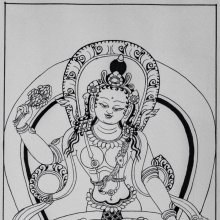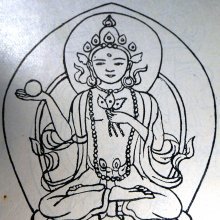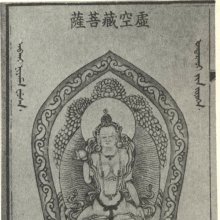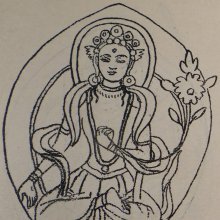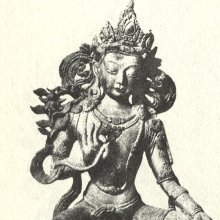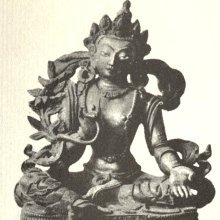Akashagarbha, Ākāśagarbha: 9 definitions
Introduction:
Akashagarbha means something in Buddhism, Pali, Hinduism, Sanskrit. If you want to know the exact meaning, history, etymology or English translation of this term then check out the descriptions on this page. Add your comment or reference to a book if you want to contribute to this summary article.
The Sanskrit term Ākāśagarbha can be transliterated into English as Akasagarbha or Akashagarbha, using the IAST transliteration scheme (?).
Images (photo gallery)
(+3 more images available)
In Buddhism
Tibetan Buddhism (Vajrayana or tantric Buddhism)
Source: Wisdom Library: Tibetan BuddhismĀkāśagarbha (आकाशगर्भ) is the name of a Bodhisattva mentioned as attending the teachings in the 6th century Mañjuśrīmūlakalpa: one of the largest Kriyā Tantras devoted to Mañjuśrī (the Bodhisattva of wisdom) representing an encyclopedia of knowledge primarily concerned with ritualistic elements in Buddhism. The teachings in this text originate from Mañjuśrī and were taught to and by Buddha Śākyamuni in the presence of a large audience (including Ākāśagarbha).
Source: archive.org: The Indian Buddhist Iconography1) Ākāśagarbha (आकाशगर्भ) (“essence of ether”) is the name of a Bodhisattva commonly depicted in Buddhist Iconography, and mentioned in the 11th-century Niṣpannayogāvalī of Mahāpaṇḍita Abhayākara.—his color is green; his symbol is the jewel.—The Bodhisattva Ākāśagarbha is also known by the name of Khagarbha, the words “Kha” and “Ākāśa” signify the same thing "Sky" Ākāśagarbha is the Bodhisattva who lives in the womb of the sky.
Ākāśagarbha is described in the Niṣpannayogāvalī (Dharmadhātuvāgīśvara-maṇḍala) as follows:—
“Ākāśagarbha is green in complexion, with the right hands he showers all kind of jewels and with the left, he holds the Cintāmaṇi (wish-giving) jewel”.
2) Ākāśagarbha (आकाशगर्भ) or Ākāśagarbhalokeśvara refers to number 49 of the 108 forms of Avalokiteśvara found in the Machhandar Vahal (Kathmanu, Nepal). [Machhandar or Machandar is another name for for Matsyendra.].
Accordingly,—
“Ākāśagarbha also is [Avalokita Lokeśvara] in all respects, except that here the god exhibits the Varada pose in the right hand and the stem of a lotus in the left.—Avalokita Lokeśvara also is one-faced and two-armed and sits in the same attitude on a lotus. He wields the sword in his right hand and holds the stem of a lotus against the chest with his left”.
The names of the 108 deities [viz., Ākāśagarbha] possbily originate from a Tantra included in the Kagyur which is named “the 108 names of Avalokiteshvara”, however it is not yet certain that this is the source for the Nepali descriptions.Source: academia.edu: A Critical Study of the Vajraḍākamahātantrarāja (II)
Ākāśagarbha (आकाशगर्भ) is the husband of Cakravarmiṇī: the name of a Ḍākinī (‘sacred girl’) presiding over Suvarṇadvīpa: one of the four Upamelāpaka (‘sacred spot’) present within the Kāyacakra (‘circle of body’) , according to the 9th-centruy Vajraḍākatantra. The Kāyacakra is one of three Cakras within the Tricakra system which embodies twenty-four sacred spots or districts resided over by twenty-four Ḍākinīs whose husbands (viz., Ākāśagarbha) abide in one’s body in the form of twenty-four ingredients (dhātu) of one’s body.
Cakravarmiṇī has for her husband the hero (vīra) named Ākāśagarbha. She is the presiding deity of Suvarṇadvīpa and the associated internal location are the ‘shanks’ and the bodily ingredient (dhātu) is the ‘sweat’.
Source: academia.edu: The Structure and Meanings of the Heruka MaṇḍalaĀkāśagarbha (आकाशगर्भ) is the name of a Vīra (hero) who, together with the Ḍākinī named Cakravarminī forms one of the 36 pairs situated in the Vajracakra, according to the 10th century Ḍākārṇava chapter 15. Accordingly, the vajracakra refers to one of the four divisions of the sahaja-puṭa (‘innate layer’), situated within the padma (lotus) in the middle of the Herukamaṇḍala. The 36 pairs of Ḍākinīs and Vīras [viz., Ākāśagarbha] each have one face and four arms; they hold a skull bowl, a skull staff, a small drum and a knife; they are dark-bluish-black in color.
Source: OSU Press: Cakrasamvara SamadhiĀkāśagarbha (आकाशगर्भ) is the name of a Ḍāka (male consort) and one of the deities of the Cakrasaṃvara-maṇḍala or Saṃvaramaṇḍala of Abhayākaragupta’s Niṣpannayogāvalī, p. 45 and n. 145; (Cf. Cakrasaṃvaratantra, Gray, David B., 2007).—The Cakrasaṃvara mandala has a total of sixty-two deities. [...] Three concentric circles going outward, the body, speech and mind wheels (kāya-vāka-citta), in the order: mind (blue), speech (red), and body (white), with eight Ḍākinīs each in non-dual union with their Ḍākas, "male consorts".
Associated elements of Cakravarmiṇī and Ākāśagarbha:
Circle: kāyacakra (body-wheel) (white);
Ḍākinī (female consort): Cakravarmiṇī;
Ḍāka (male consort): Ākāśagarbha;
Bīja: suṃ;
Body-part: calves;
Pīṭha: Suvarṇadvīpa;
Bodily constituent: prasveda (sweat);
Bodhipakṣa (wings of enlightenment): smṛtibodhyaṅga (awakening of mindfulness).

Tibetan Buddhism includes schools such as Nyingma, Kadampa, Kagyu and Gelug. Their primary canon of literature is divided in two broad categories: The Kangyur, which consists of Buddha’s words, and the Tengyur, which includes commentaries from various sources. Esotericism and tantra techniques (vajrayāna) are collected indepently.
General definition (in Buddhism)
Source: Indrajala's Dharma Depository: BuddhismĀkāśagarbha Bodhisattva 虛空藏菩薩, otherwise known as Gaganagarbha, is another prominent bodhisattva that is not so well known in the English speaking world. As his name implies, he is like a limitless treasury of wisdom and merit.
In the Ākāśagarbha Bodhisattva Sūtra the Buddha praises all his good qualities. His samādhi is like the sea. His pure precepts are like a mountain. His wisdom is like space. His effort is like the wind. His tolerance is like diamond. His wisdom is like the sands in the Ganges. He is the proper guide for people and refuge for both preta-s and animals. He is thus worthy of receiving supreme offerings from beings.
Languages of India and abroad
Sanskrit dictionary
Source: Cologne Digital Sanskrit Dictionaries: Edgerton Buddhist Hybrid Sanskrit DictionaryĀkāśagarbha (आकाशगर्भ).—m. (1) name of a Bodhisattva: Mahāvyutpatti 647; Śikṣāsamuccaya 64.14 ff.; Kāraṇḍavvūha 1.10; (Ārya-)Mañjuśrīmūlakalpa 312.4; 405.24; (2) name of a work: Mahāvyutpatti 1342; °sūtra, Śikṣāsamuccaya 10.14; 11.1; 59.10.
Source: Cologne Digital Sanskrit Dictionaries: Monier-Williams Sanskrit-English DictionaryĀkāśagarbha (आकाशगर्भ):—[=ā-kāśa-garbha] [from ā-kāśa > ā-kāś] m. Name of a Bodhisattva, [Buddhist literature]
[Sanskrit to German]
Sanskrit, also spelled संस्कृतम् (saṃskṛtam), is an ancient language of India commonly seen as the grandmother of the Indo-European language family (even English!). Closely allied with Prakrit and Pali, Sanskrit is more exhaustive in both grammar and terms and has the most extensive collection of literature in the world, greatly surpassing its sister-languages Greek and Latin.
See also (Relevant definitions)
Partial matches: Akasha, Garbha.
Starts with: Akashagarbhalokeshvara.
Full-text: Cakravarmini, Suvarnadvipa, Khagarbha, Prasveda, Smritibodhyanga, Vayucakra, Sum, Akashagarbhalokeshvara, Mahasattva, Yoginicakra, Bhucakra, Karbhara, Karbharanilaka, Vajracakra, Bodhisattva.
Relevant text
Search found 9 books and stories containing Akashagarbha, Ākāśagarbha, Akasagarbha, Akasha-garbha, Ākāśa-garbha, Akasa-garbha; (plurals include: Akashagarbhas, Ākāśagarbhas, Akasagarbhas, garbhas). You can also click to the full overview containing English textual excerpts. Below are direct links for the most relevant articles:
Ksitigarbha Bodhisattva fundamental vow sutra (by Johnny Yu)
The Indian Buddhist Iconography (by Benoytosh Bhattachacharyya)
The Great Chariot (by Longchenpa)
Part 4a.3 - Meditating on the deities < [B. The explanation of meditation practice, together with its action of ripening and freeing]
Part 8 - The individual ways of guarding aspiring and entering < [B. the extensive explanation of arousing bodhicitta]
Part 4a.4 - The great mandala of the environment and inhabitants < [B. The explanation of meditation practice]
Bodhisattvacharyavatara (by Andreas Kretschmar)
Khenpo Ape’s Advice On Studying The Bodhisattva-caryāvatāra < [Introduction Text]
Text Section 40 < [Khenpo Chöga’s Oral Explanations]
The gods of northern Buddhism (by Alice Getty)
Guhyagarbha Tantra (with Commentary) (by Gyurme Dorje)
Text 7.4 (Commentary) < [Chapter 7 (text and commentary)]
Text 4.19 (Commentary) < [Chapter 4 (text and commentary)]
Text 1.9 (Commentary) < [Chapter 1 (text and commentary)]
Related products
